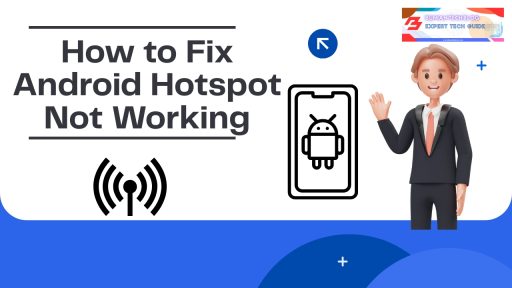Struggling to connect your laptop or tablet to your Android hotspot? You’re not alone. Whether it disconnects frequently, shows “connected without internet,” or doesn’t turn on at all, these issues can interrupt your workflow and waste time. This guide offers clear, real-world solutions to help you fix your Android hotspot and get connected again—quickly and reliably.

About This Guide
This post focuses on real solutions, not generic suggestions. If you’ve been typing “how to fix Android hotspot not working” into Google for answers, this is written for you.
We’ll explore common issues, what causes them, and step-by-step fixes. It’s based on actual user experiences, updated for 2025, and backed by practical knowledge, not guesswork.
You’ll also find long-tail keywords like:
- Android hotspot not connecting to laptop
- Hotspot connected, but no internet on Android
- Android hotspot keeps turning off automatically
These are included naturally throughout the article to help it rank better while keeping the content human and readable.
Why Android Hotspot Problems Are So Common
Many Android users run into hotspot issues because of a mix of hardware, software, and carrier restrictions. These problems aren’t necessarily because your device is faulty—most of the time, it’s the settings or background processes that cause the trouble.
Let’s break down the usual suspects:
| Problem Type | Typical Cause | Solution Path |
|---|---|---|
| Hotspot doesn’t turn on | Misconfigured settings or power-saving mode | Settings reset, manual fix |
| Devices connect, but no internet | APN problems or an expired data plan | Carrier settings check |
| Frequent disconnections | Battery saver, timeout settings | Tuning system options |
| Hotspot not detected by other devices | Incompatible frequency bands (2.4GHz/5GHz) | Change the band manually |
1. Start With a Simple Restart
Before diving deep into settings, try restarting both your Android device and the device you’re trying to connect. This clears temporary glitches that may interfere with the hotspot function.
Restarting an Android phone can resolve many connectivity issues, especially those caused by minor software glitches.
2. Reset Network Settings
A large number of hotspot problems trace back to messy network configurations. Resetting these puts everything back to factory defaults, without deleting your files.
Steps to reset:
- Open Settings.
- Go to System > Reset options > Reset Wi-Fi, mobile & Bluetooth.
- Confirm and restart your phone.
Google’s official guide on network reset walks through the process step-by-step.
3. Switch Between 2.4GHz and 5GHz Wi-Fi Bands
Some older devices (like many budget laptops) don’t support 5GHz Wi-Fi, which is commonly enabled by default in modern smartphones.
How to adjust your hotspot frequency:
- Go to Hotspot & Tethering > Wi-Fi Hotspot.
- Tap on AP Band.
- Switch from 5GHz to 2.4GHz.
Learn more about Wi-Fi frequency bands and compatibility from Intel.
4. Disable Battery Saver and Data Saver Features
Battery-saving features may block the hotspot from staying active in the background, especially when the screen turns off.
Here’s what to check:
- Open Settings > Battery and disable Battery Saver.
- Go to Settings > Network & Internet > Data Saver, and turn it off.
Here’s an in-depth explanation of Android’s Battery Saver by Google Developers.
5. Check Your Carrier’s Tethering Policy
Not all mobile plans support hotspot usage by default. Some restrict it or throttle the speed after a certain data threshold.
How to check:
- Open your mobile carrier’s app.
- Review your plan details for terms like “mobile hotspot,” “data sharing,” or “tethering.”
For example, check Verizon’s hotspot policy or T-Mobile’s tethering rules.
6. Turn On and Off Airplane Mode
This quick method resets your phone’s cellular and Wi-Fi radios. It’s a soft refresh for the network stack.
Steps:
- Enable Airplane Mode for 15–30 seconds.
- Turn it off.
- Re-enable the hotspot.
See Android Airplane Mode tips from Android Central.
7. Use USB Tethering or Bluetooth Tethering
If wireless hotspot issues persist, try using a direct connection instead. USB tethering is typically faster and more stable.
| Tethering Method | Speed | Reliability | When to Use |
|---|---|---|---|
| Wi-Fi Hotspot | Moderate | Can disconnect | When devices support it |
| USB Tethering | Fast | Very stable | For laptops/desktops |
| Bluetooth | Slow | Okay | For quick file access |
See the USB tethering setup guide for Samsung and other Android phones.
8. Set Static IP and DNS Manually (Advanced Users)
When you get “Connected but no internet,” it can sometimes be a DNS or IP conflict.
Google explains how DNS and IP settings affect connectivity.
9. Check for System or App Updates
Bugs introduced in software updates can sometimes affect tethering functions. Fortunately, manufacturers usually patch them in later releases.
Visit Google’s update support page for how to update your Android system and Google Play services.
10. Factory Reset (Only If Nothing Else Works)
This is your last option. If none of the above works and you suspect your phone has software corruption, a factory reset might help.
Here’s how to back up and reset your Android.
Video Tutorial Reference
Watch this detailed YouTube tutorial to visually follow along with the top methods explained here:
Fix Android Hotspot Not Working (YouTube) – Credit: Tech With Brett
Conclusion
When your Android hotspot isn’t working, it’s more than a technical hiccup—it can disrupt your work, study, or travel plans. Fortunately, most of these issues can be resolved with simple tweaks. From resetting your network settings to changing the hotspot band, this guide has covered everything you need.
Whether you’re a casual user or a tech-savvy professional, the right approach starts with understanding the root of the issue. Keep your system updated, be mindful of your carrier limitations, and remember: if Wi-Fi doesn’t work, USB often will.
For more advanced fixes, explore Android’s Developer Options to fine-tune how your device handles connections.





